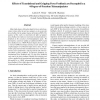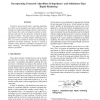109
click to vote
HAPTICS
2007
IEEE
15 years 24 days ago
2007
IEEE
This paper presents a new actuation approach which combines the use of brakes, springs and mini motors to produce a safer and more energy efficient way to drive haptic devices. Th...
109
Voted
HAPTICS
2007
IEEE
15 years 2 months ago
2007
IEEE
Due to the nature of touch sensation, the interface between a user and a haptic device must be carefully designed and selected such that the user feels they are directly manipulat...
122
Voted
HAPTICS
2007
IEEE
15 years 4 months ago
2007
IEEE
In this paper, a numerical model of the thermal process of touching an object is described. The model takes into account the object geometry and temperature, the thermal parameter...
112
click to vote
HAPTICS
2007
IEEE
15 years 4 months ago
2007
IEEE
Tactile displays can provide detailed spatial information to the skin, but little is known about the effects of vibrating displayed shapes. This study examines passive touch perce...
HAPTICS
2007
IEEE
15 years 4 months ago
2007
IEEE
Tactile displays based on pin arrays are challenging to design because they require a large number of individually controllable pins, or "tactors". A semiactive approach...
127
Voted
HAPTICS
2007
IEEE
15 years 4 months ago
2007
IEEE
Many high-degree-of-freedom haptic devices and teleoperator systems either do not have grippers or do not provide force feedback in the gripper degree of freedom (DOF). The purpos...
123
click to vote
HAPTICS
2007
IEEE
15 years 7 months ago
2007
IEEE
Both haptic and visual senses play a role in how we explore our environment. Previous studies have shown that vision plays a very strong role in perception of object stiffness, ye...
HAPTICS
2007
IEEE
15 years 7 months ago
2007
IEEE
Dynamic properties of robotic manipulators, including inertia, damping, and friction, limit the transparency of a haptic-feedback teleoperator. In this paper, we develop a positio...
111
Voted
HAPTICS
2007
IEEE
15 years 7 months ago
2007
IEEE
This paper explores the experiment design to determine a human’s ability to discriminate the natural frequency of manually excited virtual dynamic systems. We use a one degree-o...
106
click to vote
HAPTICS
2007
IEEE
15 years 7 months ago
2007
IEEE
Geometric (proxy-based) haptic rendering algorithms are widely used in impedance-type haptic rendering. Such methods are useful for developing complex virtual environment because ...






